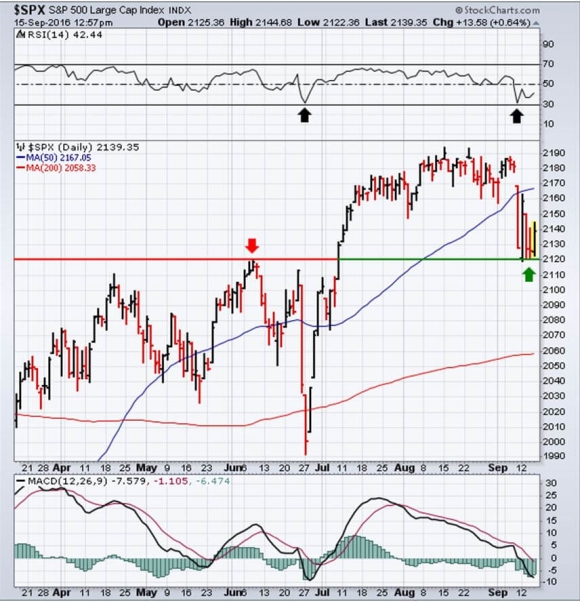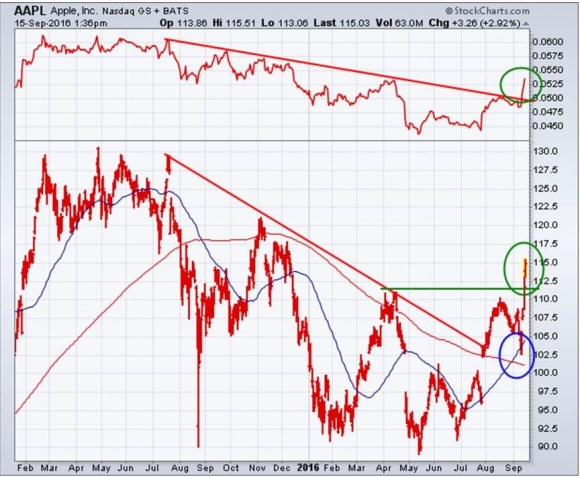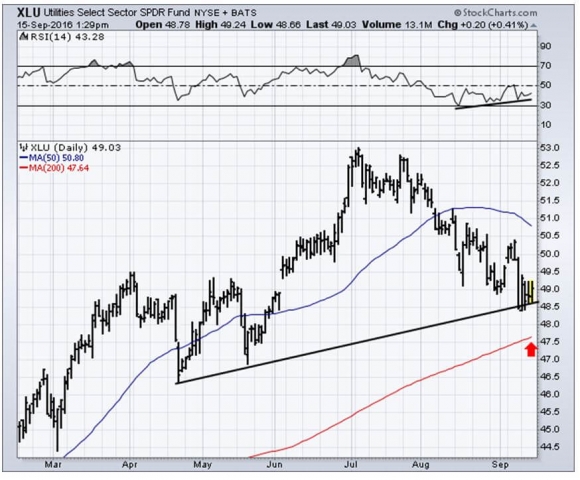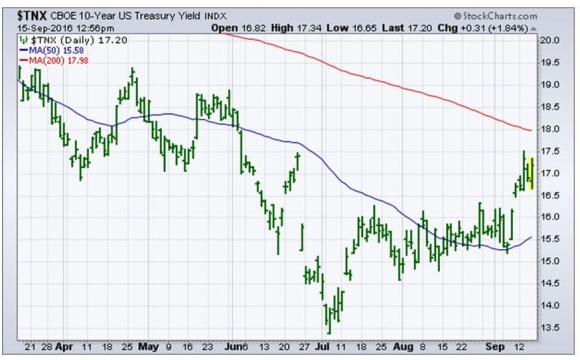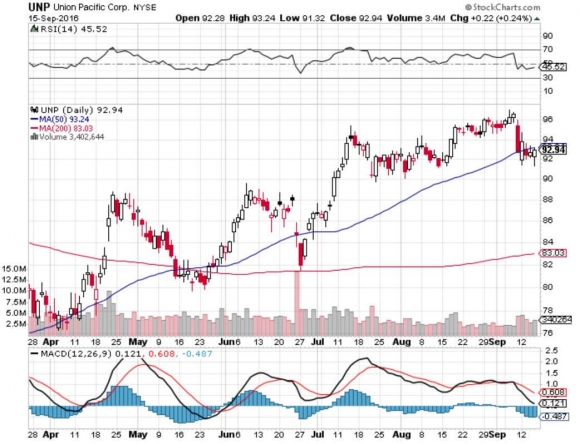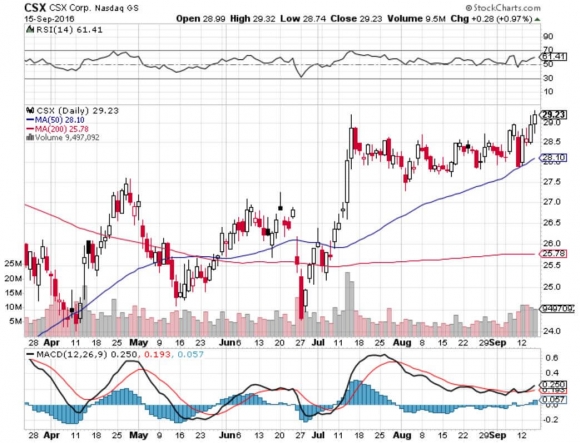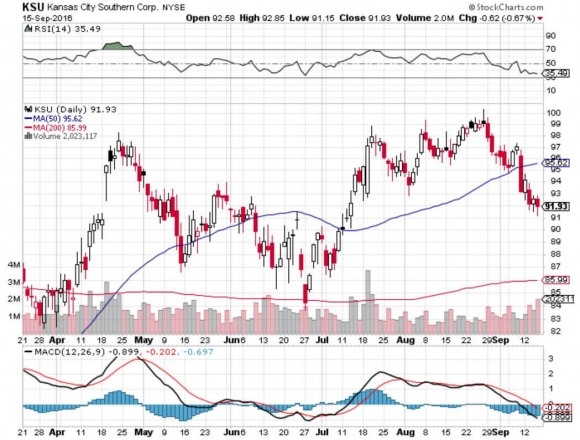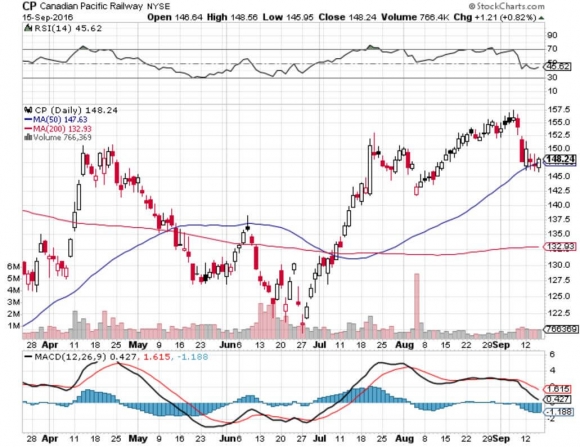While the Diary of a Mad Hedge Fund Trader focuses on investment over a one week to six-month time frame, Mad Day Trader, provided by Bill Davis, will exploit money-making opportunities over a brief ten minute to three day window. It is ideally suited for day traders, but can also be used by long-term investors to improve market timing for entry and exit points. Read more
Global Market Comments
September 20, 2016
Fiat Lux
Featured Trade:
(THE MATHEMATICAL IMPOSSIBILITY OF A TRUMP WIN),
(HOW TO EXECUTE A VERTICAL BULL CALL SPREAD ON FACEBOOK),
(FB)
Facebook, Inc. (FB)
While the Global Trading Dispatch focuses on investment over a one week to six-month time frame, Mad Options Trader, provided by Matt Buckley, will focus primarily on the weekly US equity options expirations, with the goal of making profits at all times. Read more
While the Diary of a Mad Hedge Fund Trader focuses on investment over a one week to six-month time frame, Mad Day Trader, provided by Bill Davis, will exploit money-making opportunities over a brief ten minute to three day window. It is ideally suited for day traders, but can also be used by long-term investors to improve market timing for entry and exit points. Read more
While the Diary of a Mad Hedge Fund Trader focuses on investment over a one week to six-month time frame, Mad Day Trader, provided by Bill Davis, will exploit money-making opportunities over a brief ten minute to three day window. It is ideally suited for day traders, but can also be used by long-term investors to improve market timing for entry and exit points. Read more
Global Market Comments
September 19, 2016
Fiat Lux
Featured Trade:
(MARKET OUTLOOK FOR THE COMING WEEK),
(T), (SPG), (HYG), (EEM), (ELD), (CYB), (FXY), (FXE)
(A CONVERSATION WITH THE BOOTS ON THE GROUND),
(OCTOBER 21st SAN FRANCISCO, CA GLOBAL STRATEGY LUNCHEON)
AT&T, Inc. (T)
Simon Property Group Inc. (SPG)
iShares iBoxx $ High Yield Corporate Bd (HYG)
iShares MSCI Emerging Markets (EEM)
WisdomTree Emerging Markets Lcl Dbt ETF (ELD)
WisdomTree Chinese Yuan Strategy ETF (CYB)
CurrencyShares Japanese Yen ETF (FXY)
CurrencyShares Euro ETF (FXE)
I think you can pretty much expect things to remain on hold until the Fed announces its interest rate decision next Wednesday afternoon.
That is when all financial markets will explode to the upside, the downside, or both.
So, I am going into the big day 100% in cash to take advantage of the sudden bouts of volatility.
Long-term portfolio managers should just turn off the TV and go to sleep. The moves are going to be too tight and rapid for you to trade, and we are going to new all time highs by year end anyway.
The really interesting thing about the charts below is that virtually the entire yield sensitive space is approaching major medium term support levels.
That means they could all rocket in unison if the Fed takes no action which is what I expect they will do.
That would include utilities (T), REITs (SPG), junk bonds (HYG), emerging market stocks (EEM), bonds (ELD), master limited partnerships and currencies: the Yuan (CYB), the Yen (FXY) and the Euro (FXE).
In the meantime, we have a market that has become incredibly concentrated. Of the 127 point move up in the Dow Average during the first four days of last week, an amazing 67% was accounted for by Apple (AAPL).
By the way, I have been predicting all year that Steve Jobs? creation would spike around now, and I have been proved dead on. You're welcome to those of you who bought in the spring at $92 on my advice.
If the Fed is truly data dependent, this is what the last raft of numbers looked like.
August Retail Sales dropped by 0.3%, Core Retail Sales by 0.1%, the Empire State by 1.99, Industrial Production by a heart rending 0.4%, and the Producer Price Index was unchanged.
It all adds up to a modest summer economic slowdown that kicked in during August.
Only Weekly Jobless Claims show continued strength, hovering at 43 year lows at 260,000. But there is barely a whisper of wage hikes historically seen at these employment levels.
The Fed Funds futures voted with their feet.
There is now only an 11% chance of a hike in September, and 44% in December, and the Fed NEVER votes against this key interest rate leading indicator.
It will be a big week for housing data, the most important single leg of the US economy.
But all else will pale in comparison to the Federal Open Market Committee Meeting (FOMC) concluding on Wednesday.
On Monday, September 19th at 10:00 AM we get a Housing Market Index that should show continued improvement.
On Tuesday, September 20th at 8:30 AM EST the August Housing Starts should be interesting, given the recent rise in mortgage interest rates.
On Wednesday, September 21 at 2:00 PM EST we get the Big Kahuna, the Fed interest rate decision. The comments in the press conference following the announcement will be more important than their decision NOT to raise rates, especially given presidential candidate Donald Trump?s vicious attack on Janet Yellen.
On Thursday, September 22nd we get a cornucopia of data releases. At 8:30 AM EST the Weekly Jobless Claims should confirm that employment remains at decade highs. August Existing Home Sales will be the most important housing related data release of the month.
Friday, September 23 delivers us the Purchasing Managers Index Flash Index at 9:45 AM EST. We wind up with the Baker Hughes Rig Count on Friday at 1:00 PM EST. Worryingly, the trend has been up for the past two months, driving oil prices lower.
I have been going through old boxes of hard copy photos stored in my basement, scanning them to my computer to avoid total deterioration. I will be posting some of the more fun ones when there is nothing better to do.
John Thomas
The Mad Hedge Fund Trader
Refueling in Corsica in 1985
While the Diary of a Mad Hedge Fund Trader focuses on investment over a one week to six-month time frame, Mad Day Trader, provided by Bill Davis, will exploit money-making opportunities over a brief ten minute to three day window. It is ideally suited for day traders, but can also be used by long-term investors to improve market timing for entry and exit points. Read more
Global Market Comments
September 16, 2016
Fiat Lux
SPECIAL RAILROAD ISSUE
Featured Trade:
(THE BIG COMEBACK IN RAILROADS),
(UNP), (CSX), (NSC), (CP), (KSU)
Union Pacific Corporation (UNP)
CSX Corp. (CSX)
Norfolk Southern Corporation (NSC)
Canadian Pacific Railway Limited (CP)
Kansas City Southern (KSU)
Want to know the best way to play the coming recovery in oil, commodities, precious metals, and emerging markets?
Buy the railroads. At least if you are early, you still have a functioning, cash flow positive business, unlike the rest of the above.
Since they peaked in early 2015, railroad stocks have been beaten like the proverbial red-headed stepchild, trading with the collapse in oil and coal tick for tick. Lead stock Union Pacific (UNP) has seen its share price crater by 36% since then before recently recovering half of that.
What follows a global synchronized slowdown, led by China and emerging markets? A global synchronized recovery, led by China and emerging markets.
I love railroads because they used to belch smoke and steam and have these incredibly loud, romantic, wailing whistles.
In fact, my first career goal in life (when I was 5) was to become a train engineer. By the time I was old enough to know better, American railroads almost no longer existed.
It turns out that the railroads today are a great proxy for the health of the entire global economy. They are, in effect, our canary in the coalmine.
If oil prices stay low enough for long enough, it will boost demand for everything else that Union Pacific ships, including houses, furniture, cars, and every other sweet spot for their franchise.
Union Pacific (UNP), in effect, has a great internal hedge for its many businesses. When one product line weakens, another strengthens. This has been going on since the 19th century.
The industry is carefully watching the construction of a second Panama Canal across Nicaragua (click here for ?Who the Grand Nicaragua Canal Has Worried?).
If completed by its Chinese promoters within the next decade, it could bring an incremental shift of traffic from the US West Coast to the Gulf Ports.
Even this is a mixed bag, as this will move some business away from strike-plagued ports that are currently causing so much trouble.
When I rode Amtrak?s California Zephyr from Chicago to San Francisco in 2014, I passed countless trains heading west hauling hoppers full of coal for shipment to China.
Last year? I took the same trip. The coal trains were gone. Instead I saw 100 car long tanker trains transporting crude oil from North Dakota south to the Gulf Coast. I thought, ?There?s got to be a trade here.? It turns out I was right.
Take a look at the charts below, and you will see that the shares of virtually the entire railroad industry are breaking out to the upside.
In two short years, the big railroads have completely changed their spots, magically morphing from fading coal plays to emerging oil ones.
You?ve heard of ?fast fashion?? This is ?fast railroading?.
Today the big business is coming from the fracking boom, shipping oil from North Dakota?s Bakken field to destinations south. In fact, the first trainload of Texas tea arrived here in the San Francisco Bay area only a couple of years ago, displacing crude that formerly came from Alaska.
There are a wealth of interesting companies in the railroad sector now. You could almost pick any one.
These include Union Pacific (UNP), CSX Corp (CSX), Norfolk Southern (NSC), Kansas City Southern (KSU) and Canadian Pacific (CP).
Those of a certain age, such as myself, remember railroads as one of the great black holes of American industry. During the sixties, they were constantly on strike, always late, and delivered terrible service.
A friend of mine, taking a passenger train from New Mexico to Los Angeles, found his car abandoned on a siding for 24 hours where he froze and starved until he was discovered.
New airlines and the trucking industry were eating their lunch. They also hemorrhaged money like crazy.
The industry finally hit bottom in 1970, when the then dominant Penn Central Railroad went bankrupt, freight was spun off, and the government-owned Amtrak passenger service was created out of the ashes.
I know all of this because my late uncle was the treasurer of Penn Central.
Fast forward nearly half a century, and what you find is not your father?s railroad.
While no one was looking, they quietly became one of the best run and most efficient industries in America. Unions were tamed, costs slashed, and lines were reorganized and consolidated.
The government provided a major assist with sweeping deregulation. It became tremendously concentrated, with just four companies dominating the country, down from hundreds a century ago, giving you a great oligopoly play.
The quality of management improved dramatically.
Then the business started to catch a few lucky breaks from globalization. The China boom that started in the nineties created enormous demand for shipment inland of manufactured goods from West Coast Ports.
A huge trade also developed moving western coal back out to the Middle Kingdom, which now accounts for 70% of all traffic. The ?fracking? boom is having the same impact on the North/South oil by rail business.
All of this has ushered in a second ?golden age? for the railroad industry. This year, the industry is expected to pour $14 billion into new capital investment.
The US Department of Transportation expects gross revenues to rise by 50% to $27.5 billion by 2040. The net net of all of this is that freight rates are rising right when costs are falling, sending railroad profitability through the roof.
Union Pacific is investing a breathtaking $3.6 billion to build a gigantic transnational freight terminal in Santa Teresa, NM. It is also spending $500 million building a new bridge across the Mississippi River at Canton, Iowa.
Lines everywhere are getting double tracked or upgraded. Mountain tunnels are getting rebored to accommodate double stacked sea containers.
Indeed, the lines have become so efficient, that overnight couriers, like FedEx (FDX) and UPS (UPS), are diverting a growing share of their own traffic.
Their on time record is better than that of competing truckers, who face delays from traffic jams and crumbling roads, and are still hobbled by antiquated regulation.
I have some firsthand knowledge of this expansion. Every October 1st, I volunteer as a docent at the Truckee, California Historical Society on the anniversary of the fateful day in 1846 when the ill-fated Donner Party was snowed in.
There, I guide groups of tourists over the same pass my ancestors crossed during the 1849 gold rush. The scars on enormous ancient pines made by passing wagon wheels are still visible.
During 1866-1869, thousands of Chinese laborers blasted a tunnel through a mile of solid granite to complete the Transcontinental Railroad.
I can guide my guests through that tunnel today with flashlights because Union Pacific (UNP) moved the line to a new tunnel a mile south to improve the grade. The ceiling is still covered with soot from the old wood and coal-fired engines.
While the rebirth of this industry has been impressive, conditions look like they will get better still. Massive international investment in Mexico (low end manufacturing and another energy renaissance) and Canada (natural resources) promise to boost rail traffic with the US.
The rapidly accelerating ?onshoring? trend, whereby American companies relocate manufacturing facilities from overseas back home, creates new rail traffic as well. It turns out that factories that produce the biggest and heaviest products are coming home first, providing all great cargo for railroads.
And who knew?
Railroads are also a ?green? play. As Burlington Northern Railroad owner, Warren Buffett, never tires of pointing out, it requires only one gallon of diesel fuel to move a ton of freight 500 miles. That makes it four time
s more energy efficient than competing trucks.
In fact, many companies are now looking to railroads to reduce their overall carbon footprint. Warren doesn?t need any convincing himself. The $34 billion he invested in the Burlington Northern Railroad six years ago has probably doubled in value since then.
You have probably all figured out by now that I am a serious train nut, beyond the industry?s investment possibilities.
My past letters have chronicled adventures riding the Orient Express from London to Venice and Amtrak from New York to San Francisco.
I even once considered buying my own steam railroad, the fabled ?Skunk? train in Mendocino, California, until I figured out it was a bottomless money pit. Some 50 years of deferred maintenance is not a pretty sight.
It gets worse.
Union Pacific still maintains in running condition some of the largest steam engines every built, for historical and public relations purposes. One, the ?Old 844? once steamed its way over the High Sierras to San Francisco on a nostalgia tour.
The 120-ton behemoth was built during WWII to haul heavy loads of steel, ammunition, and armaments to California ports to fight the war against Japan. The 4-8-4-class engine could pull 26 passenger cars at 100 mph.
When the engine passed, I felt the blast of heat of the boiler singe my face. No wonder people love these things! To watch the video, click here and hit the ?PLAY? arrow in the lower left hand corner.
Please excuse the shaky picture. I shot this with one hand, while using my other hand to keep my over- excited kids from running onto the tracks to touch the laboring beast.
Railroads all look like ripe, ?buy on dips? low-hanging fruit to me.
Legal Disclaimer
There is a very high degree of risk involved in trading. Past results are not indicative of future returns. MadHedgeFundTrader.com and all individuals affiliated with this site assume no responsibilities for your trading and investment results. The indicators, strategies, columns, articles and all other features are for educational purposes only and should not be construed as investment advice. Information for futures trading observations are obtained from sources believed to be reliable, but we do not warrant its completeness or accuracy, or warrant any results from the use of the information. Your use of the trading observations is entirely at your own risk and it is your sole responsibility to evaluate the accuracy, completeness and usefulness of the information. You must assess the risk of any trade with your broker and make your own independent decisions regarding any securities mentioned herein. Affiliates of MadHedgeFundTrader.com may have a position or effect transactions in the securities described herein (or options thereon) and/or otherwise employ trading strategies that may be consistent or inconsistent with the provided strategies.


